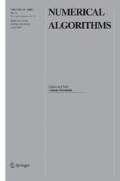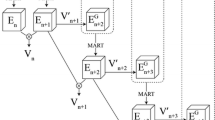Abstract
In this paper we introduce an algorithm for imaging a time varying object\(f(\vec x,t)\), from its projections at different fixed times. This algorithm differs from other algorithms in that we do not need the object to remain stationary during the data acquisition period. We show that the reconstruction of coarse features, corresponding to low spatial-frequency data, can be made nearly instantaneously in time from the evolving data. A temporal sequence of these low spatial-frequency reconstructions can be used to estimate the motion of the object. Once the motion is estimated, we may use the estimate to compensate for some of the motion of fine scale features. This enables accurate reconstructions of the time varying fine structure if the motion is not too extreme.
The algorithm is demonstrated for a selection of phantoms and actual MRI studies. In general, this technique shows promise for a wide variety of applications in MRI, as well as for heart imaging using x-ray CT. Clinical applications should include both functional MRI such as dynamic imaging of oxygen usage and blood flow in the brain, and motion imaging of joints, angiography in the lungs, and heart imaging.
Similar content being viewed by others
References
M.S. Cohen et al., Acute muscle T2 changes associated with exercise, SMRN (1991) 107.
F. Shellock, J. Mink and J. Fox, Patellofemoral joint: kinematic MR imaging to assess tracking abnormalities, Radiology 168 (1988) 551.
V. Wedeen, Magnetic resonance imaging of myocardial kinematics: A technique to detect, localize and quantify the strain rates of the active human myocardium, Magn. Res. Med. 27 (1992) 52.
R. Turner, D. LeBihan, C.T.W. Moonen, D. Depres and J. Frank, Echo-planar time course MRI of cat brain oxygenation changes, Magn. Res. Med. 22 (1991) 159.
A. Villringer et al., Dynamic imaging with lanthanide chelates in normal brain: Contrast due to magnetic susceptibility effects, Magn. Res. Med. 6 (1988) 164.
J.W. Belliveau et al., Functional cerebral imaging by susceptibility-contrast NMR, Magn. Res. Med. 14 (1990) 538.
J. van Vaals, H.H. Tuithof and W.T. Dixon, Increased time resolution in dynamic imaging, Abstract,10th Annual Meeting of the Society of Magnetic Resonance Imaging (1992) p. 44.
J.E. Bishop, I. Soutar, W. Kucharcyk and D.B. Plewes, Rapid sequential imaging with sharedecho fast spin-echo MR imaging, Works in Progress Abstract,10th Annual Meeting of the Society of Magnetic Resonance Imaging (1992) S26.
G.B. Pike, J.O. Fredrickson, G.H. Glover and D.R. Enzmann, Dynamic susceptibility contrast imaging using a gradient-echo sequence, Abstract,11th Annual Meeting of the Society of Magnetic Resonance in Medicine (1992) p. 1131.
W.A. Edelstein, J.M.S. Hutchinson, G. Johnson and T. Redpath, Spin warp NMR imaging and applications to human whole-body imaging, Phys. Med. Biol. 25 (1980) 751.
F. Farzaneh, S.J. Riederer, J.N. Lee, T. Tasciyan, R.C. Wright and C.E. Spritzer, MR Fluoroscopy: Initial clinical studies, Radiology 171 (1989) 545.
Z.-P. Liang and P.C. Lauerbur, IEEE Trans. Med. Imaging 10 (1991) 132.
S. Plevritis and A. Macovski, Resolution improvement for spectroscopic images, Abstract,11th Annual Meeting of the Society of Magnetic Resonance in Medicine (1992) p. 3820.
X. Hu and Z. Wu, SLIM revisited, Abstract,11th Annual Meeting of the Society of Magnetic Resonance in Medicine (1992) p. 3821.
P.C. Lauterbur, Image formation by induced local interactions: Examples employing nuclear magnetic resonance, Nature 242 (1973) 190.
G.H. Glover and J.M. Pauly, ‘Projection reconstruction methods for motion-robust MRI, Abstract,11th Annual Meeting of the Society of Magnetic Resonance in Medicine (1992) p. 881.
D. Healy and J.B. Weaver, Two applications of wavelet transforms in Magnetic Resonance Imaging, IEEE Trans. Inf. Theory 32 (1992) 840–860.
A.C. Kak and M. Slaney,Principles of Computerized Tomographic Imaging (IEEE Press, 1988).
S.J. Riederer, N.J. Pelc and D.A. Chesler, The noise power spectrum in computer x-ray tomography, Phys. Med. Biol. 23 (1978) 446–454.
W.R. Madych, Summability and approximate reconstruction from Radon transform data, Contemp. Math. 113 (1990) 189–219.
F. Natterer,The Mathematics of Computerized Tomography (Wiley, 1986).
T. Olson and J. DeStefano, Wavelet localization of the Radon transform, accepted, IEEE Trans. Signal Proc.
T. Olson, Construction of optimal time-frequency bases for localized tomography, Submitted to “The mathematics of computerized tomography, impedance imaging, and integral geometry”.
G. Glover and D. Noll, Consistent projection reconstruction (CPR) techniques for MRI, MRM 29 (1993) 345–351.
J.A. Reeds and L.A. Shepp, Limited angle reconstruction in tomography via squashing, Trans. Med. Im. MI-6, No. 2 (June, 1987).
G.N. Ramachandran and A.V. Lakshminarayanan, Three dimensional reconstruction from radiographs and electron micrographs: application of convolutions instead of Fourier transforms, Proc. Nat. Acad. Sci. 68 (1971) 2236–2240.
J. Jackson, D. Nishimura and A. Macovski, Twisting radial lines with application to robust magnetic resonance imaging of irregular flow, Magn. Res. Med. 25 (1992) 128–139.
C.W. Chen and T.S. Huang, Epicardial motion and deformation estimation from coronary artery bifurcation points,Proc. 3rd Int. Conf. on Computer Vision, Osaka, Japan (1990) pp. 456–460.
G.D. Meier, M.C. Ziskin, W.P. Santamore and A.A. Bove, Kinematics of the beating heart, IEEE Trans. Biomed. Eng. BME-27, 4 (1980) 319–324.
H.C. Kim et al., Estimation of local cardiac wall deformation and regional wall stress from biplane coronary cineagnigrams, IEEE Trans. Biomed. Eng. BME-27, 7 (1985) 503–511.
A. Pentland and B. Horowitz, Recovery of nonrigid motion and structure, IEEE Trans. Pattern Anal. Machine Int. PAMI-11, no. 7 (1991).
R.J. Holt and A.N. Netravali, Motion of nonrigid objects from multiframe correspondences, J. Visual Commun. Image Representation 3, no. 3 (1992) 255–271.
K.N. Ngan and W.L. Chooi, Subband motion analysis, Op. Eng. 32, no. 7 (1993) 255–271.
Author information
Authors and Affiliations
Additional information
This work was supported in part by ARPA as administered by the AFOSR under contracts AFOSR-90-0292 and DOD F4960-93-1-0567.
Rights and permissions
About this article
Cite this article
Healy, D., Olson, T. & Weaver, J. Reduced motion artifacts in medical imaging by adaptive spatio-temporal reconstruction. Numer Algor 9, 55–84 (1995). https://doi.org/10.1007/BF02143927
Issue Date:
DOI: https://doi.org/10.1007/BF02143927




